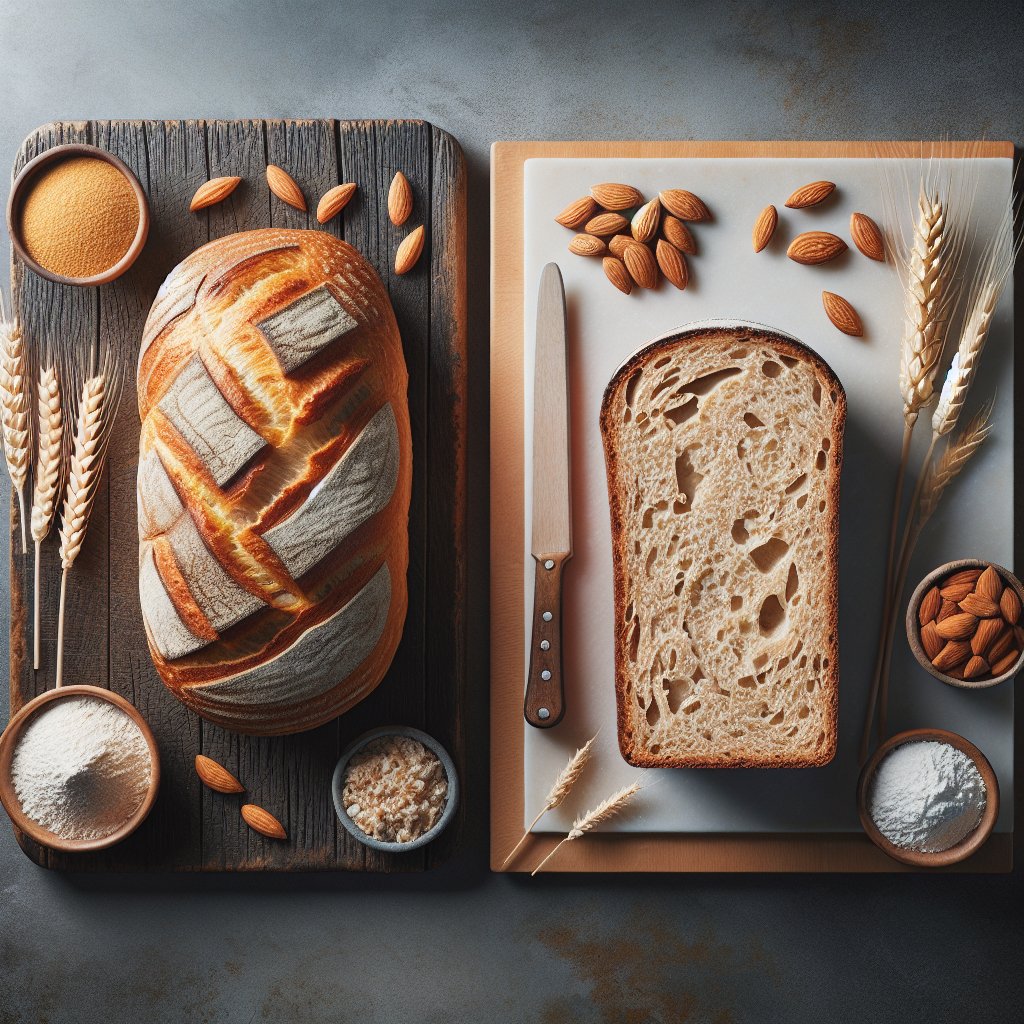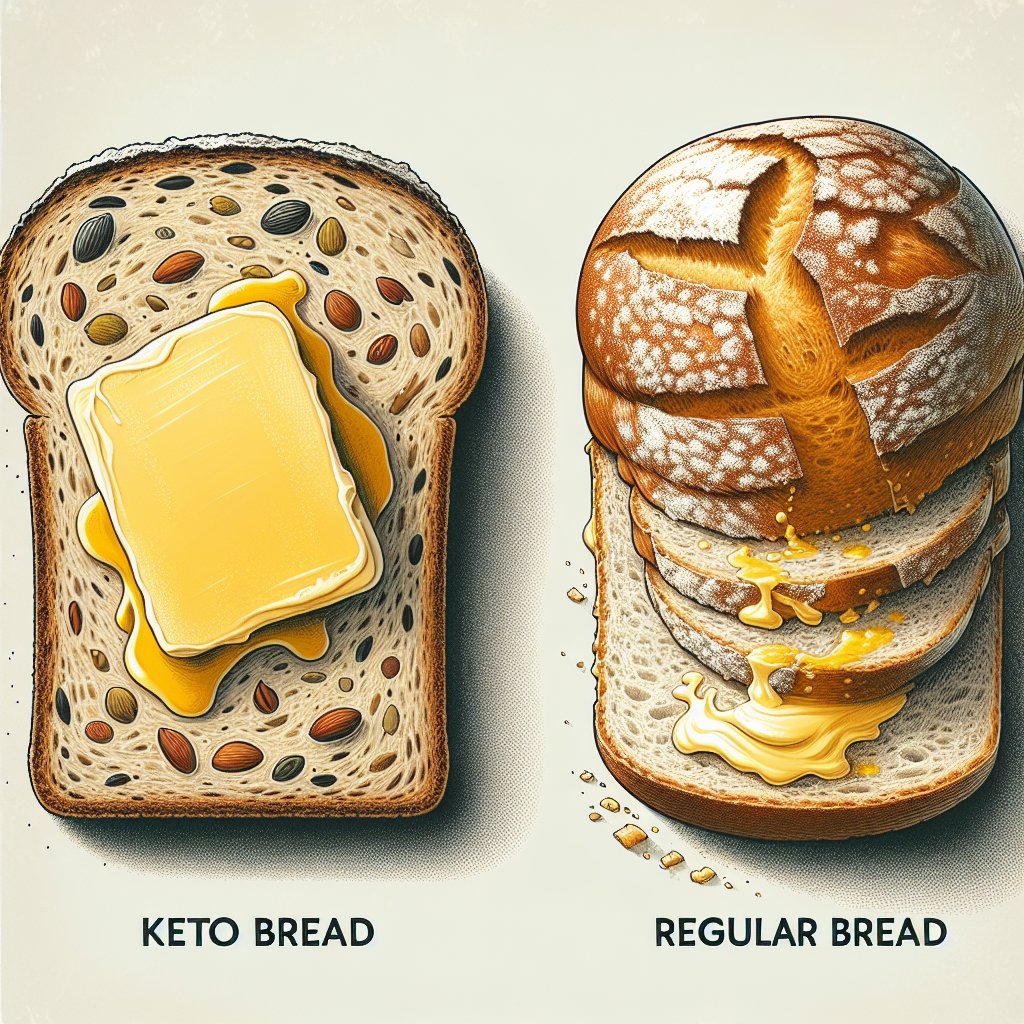Keto Bread vs Regular Bread: How is Keto Bread Different and Why You Need to Try It Now!
Brief Explanation of Keto Bread and Regular Bread
Hey there, keto enthusiasts! If you’re diving into the world of ketogenic diet and lifestyle, you’ve probably heard about keto bread. But what exactly is keto bread, and how is it different from regular bread? Let’s start with the basics.
Regular bread, you know, the kind made from wheat or grains, is a staple in many people’s diets. However, it’s also high in carbohydrates, which can spike blood sugar levels and kick you out of ketosis. On the other hand, keto bread is specifically crafted to be low in carbohydrates and high in healthy fats, making it a fitting choice for those following a keto diet.
Unlike traditional bread, keto bread typically uses alternative flours such as almond flour, coconut flour, or flaxseed meal, which are low in carbs and won’t derail your ketosis efforts. Additionally, keto bread often contains ingredients like eggs, butter, and seeds, which contribute to its high fat content, helping you stay satiated and energized.
So, how is keto bread different from regular bread? In a nutshell, keto bread is a low-carb, high-fat alternative to traditional bread, providing a tasty solution for those craving the comfort of a sandwich or toast while staying true to their keto goals. Now, let’s dive deeper into the specific differences and benefits of keto bread over regular bread. Exciting stuff ahead!

Nutritional Differences
Let’s kick things off by taking a closer look at the nutritional differences between keto bread and regular bread. It all comes down to the macronutrients – that’s your carbs, fats, and proteins – as well as the fiber and sugar content.
Macronutrients
When it comes to keto bread, the macronutrient profile is what sets it apart from regular bread. Keto bread is low in carbohydrates, which is a game-changer for those following a ketogenic lifestyle. Research published in the Journal of Nutrition highlights that reducing carbohydrate intake leads to a decrease in hunger and an increase in weight loss. On the other hand, regular bread is typically high in carbs, which can spike blood sugar levels and lead to cravings.
Fiber Content
Fiber is an essential component of a healthy diet. Keto bread, often made with almond flour or coconut flour, tends to have a higher fiber content compared to regular bread. A study in the American Journal of Clinical Nutrition suggests that a high intake of dietary fiber is associated with a reduced risk of developing various diseases, including heart disease and type 2 diabetes. So, opting for keto bread can be a smart choice to up your fiber intake.
Sugar Content
Regular bread can be a sneaky source of added sugars. On the other hand, keto bread recipes typically use sugar alternatives such as stevia or erythritol, resulting in a much lower sugar content. According to a study in the European Journal of Clinical Nutrition, excessive consumption of added sugars is linked to obesity and other metabolic disorders. By choosing keto bread, you’re making a conscious decision to cut down on unnecessary sugar in your diet.
In conclusion, the nutritional differences clearly demonstrate how keto bread stands apart from regular bread, offering a lower carb, higher fiber, and lower sugar alternative.
Now that we’ve nailed down the nutritional nitty-gritty, let’s delve into the delicious flavors and varieties of keto bread waiting to elevate your taste buds!
How is Keto Bread Different from Regular Bread?
Are you curious about how keto bread differs from regular bread? It all starts with the ingredients. Let’s take a closer look at the list of ingredients commonly used in keto bread and how they compare to those in regular bread.
Ingredients in Keto Bread
Keto bread is crafted to be low in carbohydrates and high in healthy fats and protein. Common ingredients in keto bread include almond flour, coconut flour, psyllium husk, eggs, and healthy fats like butter, ghee, or olive oil. These ingredients are chosen specifically for their low carbohydrate content and high nutritional value.
Ingredients in Regular Bread
On the other hand, regular bread is typically made with refined wheat flour, which is high in carbohydrates and can cause blood sugar spikes. It often contains added sugars, preservatives, and other additives. These ingredients can contribute to inflammation and digestive issues in some individuals, especially those with gluten sensitivities.
Now that we understand the basic ingredients, we can see the clear differences between keto bread and regular bread. While keto bread focuses on low-carb, high-fat, and nutrient-dense ingredients, regular bread tends to be higher in carbs and may contain potentially inflammatory components.
By choosing keto bread over regular bread, you can enjoy a delicious bread alternative that supports your ketogenic lifestyle, helps maintain stable blood sugar levels, and provides essential nutrients without the drawbacks of traditional bread.
Next, let’s explore the impact of these ingredient differences on the nutritional value of keto bread versus regular bread.

Benefits of Keto Bread
One of the most exciting aspects of the ketogenic diet is the innovation it has brought about in the form of keto-friendly substitutes for our favorite comfort foods. Among these, keto bread stands out as a game-changer, offering a range of potential benefits beyond just being low-carb. Let’s delve into the potential benefits of keto bread and how it differs from regular bread!
Weight Loss
Research published in the International Journal of Obesity suggests that low-carbohydrate diets can be more effective for weight loss than low-fat diets, with individuals experiencing greater weight loss and reduction in body fat percentage. This is where keto bread comes in. It’s made with alternative, low-carb flours such as almond or coconut flour, which are higher in fiber and healthy fats. These ingredients can help keep you feeling full and satisfied, making it easier to adhere to your weight loss goals.
Blood Sugar Control
A study published in Diabetes Care found that a low-carbohydrate diet can improve glycemic control and reduce medication use in patients with type 2 diabetes. Since keto bread is significantly lower in carbs compared to regular bread, it may have a minimal impact on blood sugar levels, making it a favorable option for those looking to manage their blood sugar levels.
These potential benefits make keto bread an appealing option for individuals seeking to lose weight, manage their blood sugar, or simply reduce their carbohydrate intake.
Comparison of Taste and Texture: Keto Bread vs Regular Bread
One of the biggest concerns for anyone considering the switch to a ketogenic diet is bidding farewell to the beloved aroma of freshly baked bread and the delightful taste and texture of a good old sandwich. However, fear not! Keto bread is here to save the day, and it’s not as different as you might think.
Taste:
When it comes to the taste of keto bread versus regular bread, the experience can vary depending on the recipe and ingredients. Keto bread, typically made with almond flour, coconut flour, or flaxseed meal, has a nuttier and slightly denser taste compared to traditional wheat bread. However, many enthusiasts find the flavor to be pleasantly satisfying, especially when toasted. With the right combination of ingredients and seasoning, keto bread can be a delicious alternative for those craving the taste of bread while following a low-carb lifestyle.
Texture:
The texture of keto bread is another aspect to consider. While regular bread has a soft and airy texture, keto bread tends to be denser and more filling due to the absence of gluten. That said, some keto bread recipes have successfully mimicked the fluffiness of traditional bread by incorporating psyllium husk or whey protein isolate. With creative experimentation and the right techniques, it’s amazing how close the texture of keto bread can come to the real thing.
Overall, the taste and texture of keto bread may differ from regular bread, but it’s important to approach it with an open mind and a willingness to explore new flavors and experiences. Once you find the right recipe that suits your palate, keto bread can become an enjoyable and satisfying part of your low-carb lifestyle.

Cost: Is Keto Bread Worth the Investment?
When it comes to comparing the cost of keto bread to regular bread, there are a few key factors to consider. While it’s true that keto bread may have a higher price tag than traditional bread, there are several aspects that can level out the playing field.
First and foremost, the ingredients used in keto bread are typically of higher quality and often gluten-free, making them more nutritious. A study published in the Journal of Nutrition and Metabolism highlighted that the consumption of a low-carbohydrate, high-fat ketogenic diet leads to improvements in blood lipid profiles, making it a beneficial dietary choice for many individuals.
Moreover, when you consume keto bread, you’re not just filling up on empty calories. The higher fat and protein content in keto bread can keep you feeling fuller for longer, potentially reducing the overall quantity of bread needed for a satisfying meal or snack. This aligns with a study in Nutrients, which demonstrated that a low-carbohydrate, high-fat diet may result in greater weight loss compared to a low-fat diet over a 12-month period.
While the initial investment in keto bread may be slightly higher, the potential health benefits and satiety it offers make it a compelling choice for those following a ketogenic lifestyle. The value of feeling energized, satisfied, and nourished by what you consume cannot be understated; therefore, the cost of keto bread is not just about the price on the tag, but also the overall benefits it provides.
Availability: Where to Find and Purchase Keto Bread
While regular bread is easily found in almost every grocery store, finding keto bread may require a bit more effort. However, with the increasing popularity of the ketogenic diet, the availability of keto-friendly products, including bread, has significantly improved in recent years.
You can find keto bread in specialty health food stores, some larger chain supermarkets, and online retailers. When searching for keto bread, look for low-carb, high-fiber options that are free from refined grains and sugars. Some popular brands of keto bread include Base Culture, Sola, and ThinSlim Foods.
It’s essential to check the labels to ensure that the keto bread you choose aligns with your dietary goals. Keto bread is different from regular bread as it is typically made with alternative flours like almond or coconut flour, which are lower in carbohydrates. Moreover, keto bread often contains added fiber and healthy fats, making it a more filling and satisfying option compared to regular bread.
Conclusion
In conclusion, making the switch from regular bread to keto bread can have a significant impact on your health and well-being. The key differences lie in the ingredients and nutritional values. Unlike regular bread, which is typically high in carbohydrates and can spike blood sugar levels, keto bread is low in carbs and high in healthy fats, making it a great choice for those following a ketogenic lifestyle.
When choosing keto bread, look for options made with almond flour, coconut flour, or flaxseed meal, as these are nutrient-dense alternatives to traditional wheat flour. Additionally, checking the label to ensure it’s free from added sugars and unnecessary fillers will help you make the best choice for your health.
By incorporating keto bread into your diet, you can enjoy delicious sandwiches, toast, and other bread-based recipes while staying in ketosis. So, why not give keto bread a try and experience the difference for yourself? Your taste buds and your body will thank you for it!


